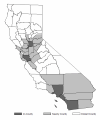Disparities in access to specialized epilepsy care
- PMID: 24008077
- PMCID: PMC3818489
- DOI: 10.1016/j.eplepsyres.2013.08.003
Disparities in access to specialized epilepsy care
Abstract
Objective: To examine the impact of individual and community characteristics on access to specialized epilepsy care.
Methods: This retrospective cross-sectional study analyzed data from the California State Inpatient Sample, the State Ambulatory Surgery Database, and the State Emergency Department Database, that were linked with the 2009 Area Resource File and the location of the National Association of Epilepsy Center's epilepsy centers. The receipt of video-EEG monitoring was measured and used to indicate access to specialized epilepsy care in subjects with persistent seizures, identified as those who had frequent seizure-related hospital admissions and/or ER visits. A hierarchical logistic regression model was employed to assess barriers to high quality care at both individual and contextual levels.
Results: Among 115,632 persons with persistent seizures, individuals who routinely received care in an area where epilepsy centers were located were more likely to have access to specialized epilepsy care (OR: 1.81, 95% CI: 1.20, 2.72). Interestingly, the availability of epilepsy centers did not influence access to specialized epilepsy care in people who had private insurance. In contrast, uninsured individuals and those with public insurance programs including Medicaid and Medicare had significant gaps in access to specialized epilepsy care. Other individual characteristics such as age, race/ethnicity, and the presence of comorbid conditions were also associated with disparities in access to specialized care in PWE.
Conclusion: Both individual and community characteristics play substantial roles in access to high quality epilepsy care. Policy interventions that incorporate strategies to address disparities at both levels are necessary to improve access to specialized care for PWE.
Keywords: Epilepsy; Healthcare access; Healthcare disparities.
Copyright © 2013 Elsevier B.V. All rights reserved.
Figures
References
-
- Agency for Healthcare Research and Quality HCUP Supplemental Variables for Revisit Analyses. 2013 Retrieved July 4, 2013, from http://www.hcup-us.ahrq.gov/toolssoftware/revisit/revisit.jsp#user.
-
- Agency for Healthcare Research and Quality HCUP Supplemental Files for Revisit Analyses. 2012 Retrieved July 4, 2013, from www.hcup-us.ahrq.gov/toolssoftware/revisit/revisit.jsp.
-
- Agency for Healthcare Research and Quality HCUP Databases. 2011 Retrieved July 4, 2013, from http://www.hcup-us.ahrq.gov/databases.jsp. - PubMed
-
- Andersen RM. National health surveys and the behavioral model of health services use. Med Care. 2008;46:647–653. - PubMed
Publication types
MeSH terms
Grants and funding
LinkOut - more resources
Full Text Sources
Other Literature Sources
Medical


